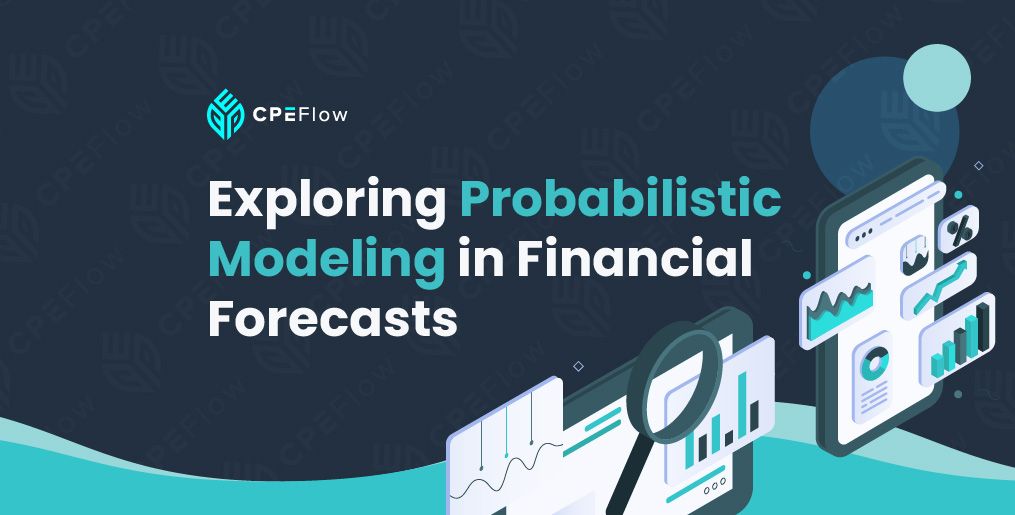Exploring Probabilistic Modeling in Financial Forecasts
Jul 9
/
Nathan Liao, CMA

In today's business world, uncertainty is the only constant. So the real question is this—how can finance professionals navigate it with confidence?
When making decisions in this environment, using single-point estimates might seem like the easiest way to minimize the complexity. However, these fixed assumptions don't always reflect the reality of market shifts, economic fluctuations, supply chain disruptions, or unexpected risks or opportunities.
This is where probabilistic modeling comes into play. Instead of focusing on only one possible outcome, this approach considers a full range of scenarios and their respective likelihoods. For finance professionals, it offers a more realistic approach to planning, forecasting, and making informed decisions in the face of uncertainty.
Want to explore probabilistic thinking and modeling further? CPE Flow's course will equip you to apply these techniques in real-world financial forecasting and make better, data-driven decisions.
What is Probabilistic Thinking and Probabilistic Modeling?
If you base all your decisions on single-point estimates, you're giving yourself a false sense of certainty and security. That's where probabilistic thinking comes into the picture.
Probabilistic thinking encourages you to consider a range of possible outcomes and estimate the likelihood of each one happening. With this mindset, you can make more informed decisions even when working with imperfect information or in an ever-changing environment.
Probabilistic modeling puts this thinking into practice. Using tools and simulations, these models help represent uncertainty and variability in your data.
For example, instead of simply stating, "We expect $1 million in revenue next year," a probabilistic model might show there's a 60% chance revenue falls between $950,000 and $1.1 million, a 30% chance it exceeds $1.1 million, and a 10% chance it falls below $950,000.
Probabilistic modeling enables you to evaluate various scenarios and select the options most likely to succeed while minimizing risk. This allows your business to better prepare for risks and opportunities.
What is the Role of Probabilistic Modeling in Financial Forecasting?
Financial forecasting is all about estimating how a company might perform in the future by examining factors like past results, market trends, and current business conditions. These forecasts enable leaders, stakeholders, and finance professionals to make more informed decisions.
In reality, things can go sideways very quickly, and this uncertainty needs to be taken into consideration. That's where probabilistic modeling comes in. It adds a layer of flexibility by showing a range of possible outcomes and how likely each one is.
When you bring probabilistic modeling into your forecasting, your predictions don't just look more realistic but also become more actionable. Leaders can weigh risks, explore different scenarios, and make decisions with greater confidence, knowing the forecast has taken into account real-world uncertainty.
Get Exclusive Access & Special Discounts!
Get early bird access to new CPE courses and exclusive discounts only shared with our email subscribers.
Distribution Curves and S-Curves
If you're going to implement and visualize uncertainty and possible outcomes, you'll likely come across different concepts and models, including distribution curves and S-curves.
Let's explore each of these in a little more detail.
Distribution Curves
Distribution curves illustrate the range of possible results and the likelihood of each occurring.
For example, in a bell-shaped curve (normal distribution), most outcomes cluster around the average, with fewer results occurring at the extremes. This helps businesses quickly grasp the most probable outcomes versus more unlikely scenarios.
S-Curves
S-curves, or cumulative probability curves, build on this by showing the likelihood of reaching a particular threshold.
Let's say you want to gauge how much money your company will make in the next few months. An S-curve might reveal there's an 80% chance of meeting the minimum revenue target.
Essentially, this is handy for evaluating risk and understanding how performance aligns with goals.
Flying Bars
Flying bars can be mapped to normal distribution curves and S-curves to help visualize uncertainty in a clear, practical way. They show the spread between the best-case, worst-case, and most likely outcomes for a given scenario.
Flying bars can come in handy when comparing different products, projects, or strategies side by side. For example, they can help highlight which option carries greater uncertainty or which offers a more favorable range of outcomes.
What is the Monte Carlo Simulation?
The Monte Carlo simulation involves the random sampling of inputs. You can use this technique to virtually simulate or demonstrate a strategy, where the model runs thousands of possible scenarios and gives you the result of each one. This model focuses on repeating the simulation many times over while assigning different values to each variable.
Rather than producing a single fixed forecast, this method generates a broad and flexible view of what might happen based on random variables in an ever-changing market.
For example, you might utilize a Monte Carlo simulation for revenue forecasting. This simulation may take into account the numerous variables that can impact your business's revenue, including pricing changes, sales volume, conversion rates, and retention rates. The model runs thousands of variations using different combinations of these variables. The results are then plotted to show the probability of different revenue levels, from best-case to worst-case scenarios.
This approach gives finance professionals practical insight into both risk and opportunity. Of course, it doesn't remove uncertainty. However, in a world where unexpected changes can come knocking at your door at any moment, it can help you see them coming and plan for them more effectively.
Step-by-Step Guide to Applying Probabilistic Modeling
Now that you have a better idea of standard models and techniques, let's go through a brief step-by-step guide on how you can apply probabilistic modeling in your business or organization.
- Define the business problem or decision. Clearly state what you're trying to solve—whether it's forecasting revenue, assessing project risk, or evaluating investment scenarios. A focused objective keeps the model practical and relevant.
- Identify key variables. Determine which factors significantly influence the outcome, such as pricing, operating costs, demand, or market conditions. You can also define realistic probability distributions based on historical data or industry benchmarks.
- Gather reliable data. Collect historical performance data, market research, and expert input to inform your assumptions and probability estimates.
- Choose or build a suitable model. Use Excel with simulation tools or other suitable software to link your key variables to the outcome using formulas. The model should reflect how changes in inputs drive the final results.
- Validate the model. Test your model using historical data or well-understood scenarios. Check that the output aligns with real-world outcomes and that the model behaves as expected across different inputs.
- Run simulations and interpret results. Conduct simulations (such as Monte Carlo) to produce a range of possible outcomes. Analyze the results using visual tools, such as distribution curves, probability bands, or S-curves, to understand the likelihood of different scenarios.
- Communicate insights and inform decisions. Present the findings clearly and tailor the content and level of detail to your audience. Highlight key risks, opportunities, and how the probabilities of different outcomes may influence strategic choices.
- Review, refine, and update regularly. Treat your probabilistic model as a living and breathing tool. As new data becomes available or business conditions change, revisit and update the model to maintain its accuracy and usefulness.
By following these best practices, finance teams can avoid the common pitfalls of relying on rigid, single-point estimates.
Embracing Uncertainty Through Probabilistic Modeling
Without probabilistic thinking, approaching today's fast-changing business environment is like rolling the dice and assuming it will always land on six.
Probabilistic modeling allows you to incorporate uncertainty into your plans from the get-go. By learning to apply these techniques in financial forecasting, finance professionals can help their organizations plan more realistically and assess risks more effectively.
If you want to gain a deeper understanding of how to apply probabilistic modeling and interpret different output formats, CPE Flow's Probabilistic Modeling Course is a great place to start. This self-paced course lets you build these skills from the comfort of your own home while earning NASBA-approved CPE credits.
Thank you for reading,

Nathan Liao, CMA
Empty space, drag to resize
Nathan Liao, a Certified Management Accountant, educator, and influential business figure in the accounting industry, has dedicated over a decade to supporting more than 82,000 accounting and finance professionals in their pursuit of the CMA certification. As the visionary founder of CMA Exam Academy and CPE Flow, Nathan is committed to delivering premier online training solutions for the next generation of accounting and finance professionals.
Explore Our Self-Paced CPE Courses
CPE Flow
© 2022 - 2025 CPE Flow, LLC. All Rights Reserved.
Refund & Complaint Policies
Requests for refunds must be made in writing within 5 days of purchasing the course. No refunds or credits will be provided after this point or if the final assessment is completed. CPE Flow issues refunds within 30 days in the same format as the payment was received. The refund amount is based on the timeframe in which the request was submitted (see table).
| Request Timeframe |
Refund/Credit Amount |
|
≤ 2 Hours |
100% Refund* |
|
> 2 Hours ≤ 48 Hours |
90% Refund* or 100% Credit** |
|
> 48 Hours ≤ 5 Days |
0% Refund or 50% Credit** |
* If a credit card was used for purchase, the 3.5% credit card fee will be deducted from the refund amount.
**Credit can be applied towards the same offering at a later date or a different offering.
For complaints or concerns, please email support@cpeflow.com
